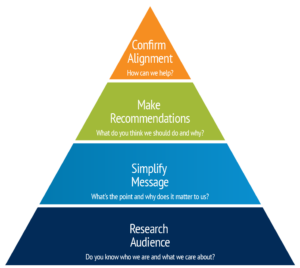Communicating ROI
You’ve been able to calculate a great ROI on your Leadership Development Program.
Now, your challenge is communicating that ROI to your Senior Leaders.
When communicating to Sr. Leaders, you know you’ve been successful when there is buy-in, you hear their perspective, and there is a clear go forward (ideally, with your recommendation).
So, how do you design your presentation to have the most impact?
There are 4 keys to influencing Sr. Leaders.
 Ask yourself the question: Who are you presenting to, and what to do they care about?
Ask yourself the question: Who are you presenting to, and what to do they care about?
Consider the following:
- Power – Who’s in the room, and who is the decision maker, the influencers, the advocates, and the detractors?
- Context – How much do people know about what you are talking about? How do you speak at a level that helps everyone understand in common, simple terms?
- Urgency and Importance – What matters to your audience based on their different roles and hot button topics/issues?
Did you know that “people make a decision in the first 30 seconds of a presentation/communication about whether or not they are going to listen to you?”

Consider the following:
- Create interest: Start with why – Reference a major business objective/goal, and state exactly what you’ll need from them at the end of the presentation.
- Set context: Clarify current state – Use facts to share where you currently are. This is what you want to address.
- Make it quick and to the point – Try to sum up your key point in 1-2 sentences.
Present your ROI, show the business impact, and make a future recommendation.
The ROI of your program is impactful – don’t sell yourself short. Own the ROI, and advocate for more.

Remind them: “At the start of our time, I had asked you to think about (purpose of the meeting).”
Get clarity: “To move this forward, what do you need?” “Is there anything else I’m missing before we can move forward?”
Recap next steps: “By (this date), (responsible party) is going to (action).” Get clear and specific on what has been agreed upon.
Successful communication is both about the preparation as well as delivery. If you want to discuss how to better develop the executive skills of your Leaders, contact us at: sales@coachingrightnow.com.







